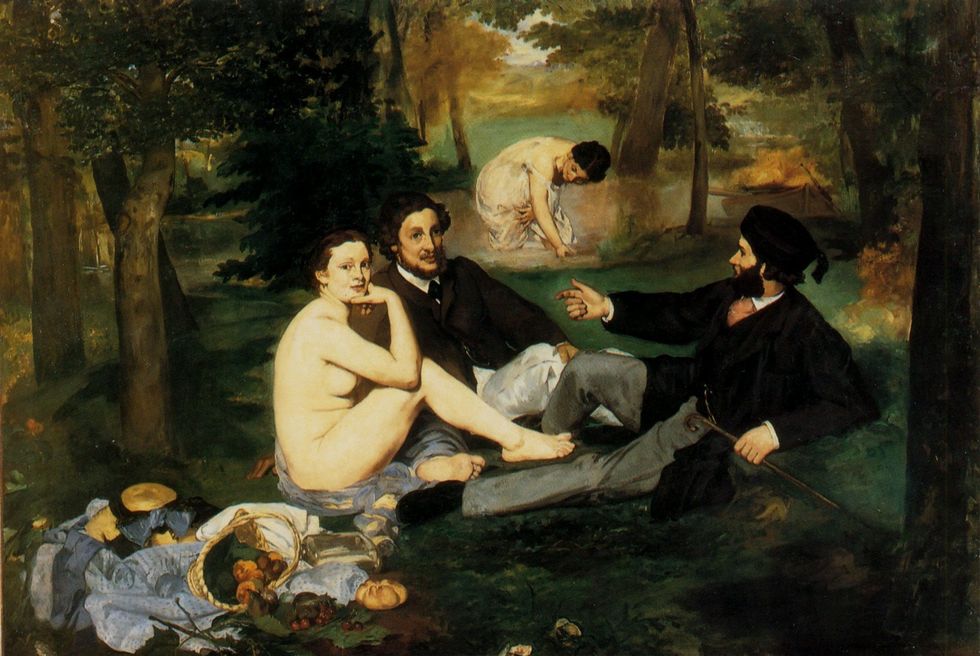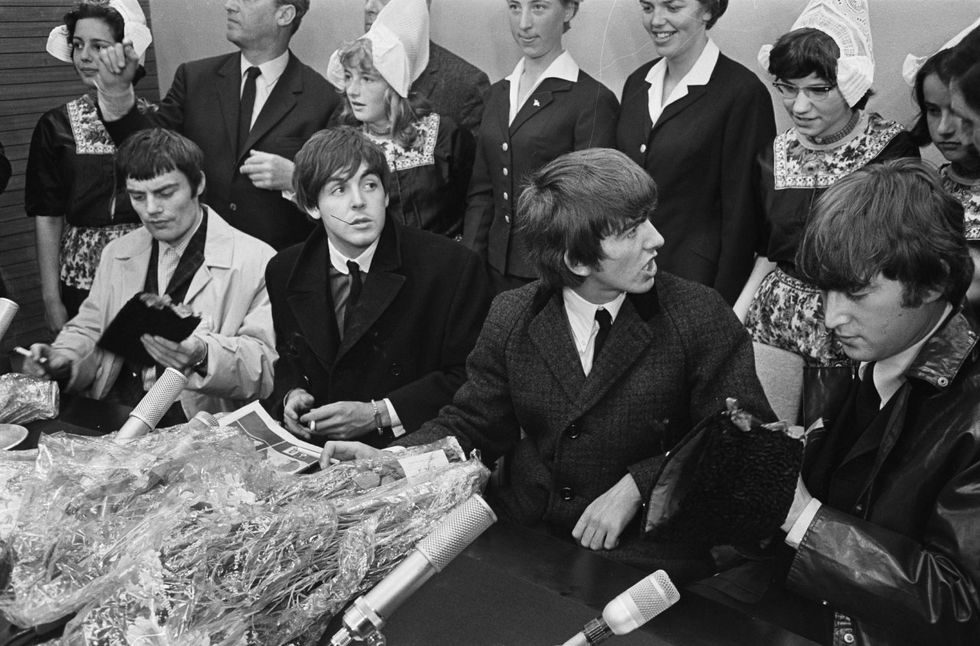Académie des Beaux-Arts was an academy and a world-renowned judge of art. Anyone who wanted to reach fame and garner acclaim submitted their works. What was accepted was good art, what did not was considered undesirable. This is critical to understanding the role a critic plays in art history; what gets judged as good art and why it immensely impacts the art that gets attention and subsequently becomes immortalized.
What students learn in art history classes owes a lot to that construct. Pieces did not reach immortalization or artists noticed by newspapers with sheer luck. Rather, there was a process under the guise of objective but was based on subjective criteria. For example, works could be submitted in categories. Some had a higher ranking than others because pieces of that style were deemed classic and the finest aesthetic.
Established in 1648, the academy immersed itself in educating promising artists. Academic art imposes what is the correct way to paint. Even from there, the guidelines limit the artist's perspective and dampens a field beloved for limitless potential. Initially, only art by its school graduates could be exhibited. From the start, it had an elitist approach that feeds a cycle of the same family and descendants getting an education and portfolio platform.
Rather than regurgitate the same names or create a claustrophobic environment, the Salon loosened its attendee requirement, creating an open field. That would be as far as liberty would get. The criteria for what was acceptable echoed what its school taught. Art and its centuries of history were narrowed into five categories of admission organized in importance: History Painting, Portraiture, Genre Painting, Landscape, and Still Life.
Admission, scholarship, prize money, and pricing depended on that criteria. Art could be considered worthless if the academy deemed it so. Also, if art reviewers say the art is not good and valueless, then it trickles down and the art cannot be sold for a high price in the market. The academy was the 'make it or break it' for many just beginning their careers.
These ideas give heavy attention to the affluent side of art history, where those of nobility and wealth could afford to commission paintings. Also, the lingering need to replicate life as close as possible with organic shapes and visibility of brushstrokes. While opinions can differ what art is the best to gaze upon, the absence of differing styles from education to exhibitions shut the academy off from changing attitudes.
Highlighted and most notably was their art exhibition, the Salon. Artworks were displayed in Paris starting in 1667. For the next 150 years, it was the world's most prestigious biannual and annual art display. 500,000 people would gather from across the world to attend its eight-week run. The Salon was a must-see, despite aristocratic buyers being the true target audience. Its walls are famed and recollected for being jam-packed with art, as much that could fit without collapsing. Every texture and size brought the venue to life. Concentrating art allowed for a compact viewing, a viewer emerging from every angle.
That was the only venue where painting and sculpture could be publicly displayed. Otherwise, art would remain in private collections. When navigating art history, it is important to understand its nature. The role of art was far from creating designs for the love of designs. Rather, commissions had propagandistic goals; art was made for gods as worship votives to gain luck and to depict oral stories and reflect on them in venues like Ancient Greece's symposium.
It would be its stringent and relentless criteria that would be its demise. Impressionist pieces from the late 1700s drew the world's attention. People admired the rapid brushstrokes, mystifying everyday views and adding a serene and colorful tough. Other art movements, such as Symbolism, were picking up steam. Rather than paint reality in true form, the avant-garde movements were embracing modernist approaches and rejecting reality. Seeking to represent literature and ideas, canvases were no longer for documentation or portraiture.
However, Salon judges refused to admit these avant-garde movements. Also, they tended to have a conservative approach in selections. A perceived idea of what exactly was art had molded and there was resistance to change. Fine attention to realism existed from Ancient Greece to the humanization of religious beings in Renaissance oil on canvases.
With the Salon being the only outlet, more submissions increased by fresh names. But the gallery did not expand to meet the demand, causing each year to have a higher turn away. An artistic pushback was inevitable. The rebellion began in 1863, which saw an unusually large amount of rejected submitted paintings – 3,000 from a pool of 5,000. Getting art seen went from competitive to near impossible. Edouard Manet and Paul Cezanne's works were in the discard pile.
The opposition insisted that their art was rejected because it did not conform to narrative settings whereas bland, common academic art was seeping through. The Salon was not for the most boundless, thought-provoking and stimulating art someone can explore, but a mere abundance of a few redundant types of art.
Today, those aforementioned artists crystalize the medium. Their works hang in the grandest of museums and are considered of significant importance and value when examining art history and their movements. Exuberant sums of money fly in the air to own their pieces and discussions are dedicated to close readings of the pieces.
To put into scale the initial outrage, France's Emperor Napoleon III visited the Salon to discuss the matter. Napoleon told the venue that the rejected artworks were as good as those accepted. But the decision was irreversible. The leader made an announcement about the decisions and gave permission to rejected painters to exhibit their pieces in a space located next to the Salon. It was a declaration against the Salon's opinions and exclusivity. Salon des Refusés, thus, was born.
Remaining true to human nature, with every limitation there is a pushback, and every restriction there is a newfound openness. While counter-movements were not unheard of, this feature earns the status of a succès de scandale. That term is applied to rebels whose ideas people get behind, having financial backing and massive press publicity to put their money where their mouth is. A large turnout of 7,000 people appeared to engage in what some art critics hailed as absurd and bizarre pieces.
Salon des Refusés and the press frenzy surrounding it became an artist haven and source of inspiration. It was proof to others that their work can be seen and admired, beyond an outdated hierarchy. It challenged ideas of what art is and can do. Beforehand, this was not always the case and many artists became forgotten by history as a result of that.
In many ways, its controversial stance pioneered modern art. Besides rejection from the Salon, artists began to consciously challenge academic art. The Salon depicted mostly male nudity in forms of superiority and female nudes with delicate, unassuming positioning. In contrast, Salon des Refusés radically boosted hyper-sexual sensationalism of the naked female body.
Another example of exemplifying the pushback was the annual Salon des Indépendants founded in 1884. Juries were absent from the admitting process with no prize offered, removing the burden from artists in love with their work and hungry to make a living. Revolutionary in its open policy, it allowed any type of art in. Only a fee was required. Viewers and buyers decided its worth in opinion and pricing. Unfortunately, this show fell under the radar, reinforcing the struggles independents faces when branching from the art world's elite traditions.
The Salon's reputation for the sole decider of art faded as the public abandoned it, a show of force and shift in power. By 1881, the academy itself severed the school from the Salon. Nonetheless, it is important to recognize its historic importance and how its authoritative tradition can be observed today across other mediums.









 Going to the cinema alone is good for your mental health, says science
Going to the cinema alone is good for your mental health, says science












 women in street dancing
Photo by
women in street dancing
Photo by  man and woman standing in front of louver door
Photo by
man and woman standing in front of louver door
Photo by  man in black t-shirt holding coca cola bottle
Photo by
man in black t-shirt holding coca cola bottle
Photo by  red and white coca cola signage
Photo by
red and white coca cola signage
Photo by  man holding luggage photo
Photo by
man holding luggage photo
Photo by  topless boy in blue denim jeans riding red bicycle during daytime
Photo by
topless boy in blue denim jeans riding red bicycle during daytime
Photo by  trust spelled with wooden letter blocks on a table
Photo by
trust spelled with wooden letter blocks on a table
Photo by  Everyone is Welcome signage
Photo by
Everyone is Welcome signage
Photo by  man with cap and background with red and pink wall l
Photo by
man with cap and background with red and pink wall l
Photo by  difficult roads lead to beautiful destinations desk decor
Photo by
difficult roads lead to beautiful destinations desk decor
Photo by  photography of woman pointing her finger near an man
Photo by
photography of woman pointing her finger near an man
Photo by  closeup photography of woman smiling
Photo by
closeup photography of woman smiling
Photo by  a man doing a trick on a skateboard
Photo by
a man doing a trick on a skateboard
Photo by  two men
two men  running man on bridge
Photo by
running man on bridge
Photo by  orange white and black bag
Photo by
orange white and black bag
Photo by  girl sitting on gray rocks
Photo by
girl sitting on gray rocks
Photo by  assorted-color painted wall with painting materials
Photo by
assorted-color painted wall with painting materials
Photo by  three women sitting on brown wooden bench
Photo by
three women sitting on brown wooden bench
Photo by 
 Photo by
Photo by  Photo by
Photo by  Photo by
Photo by  Photo by
Photo by 


 people sitting on chair in front of computer
people sitting on chair in front of computer











